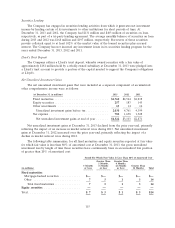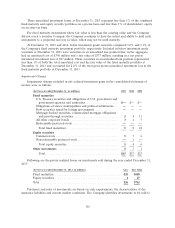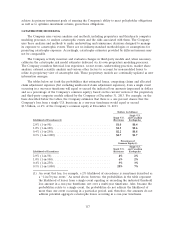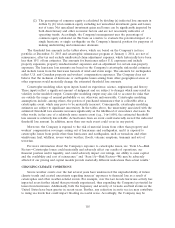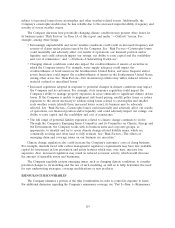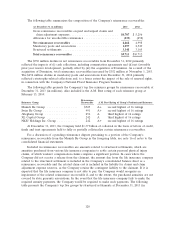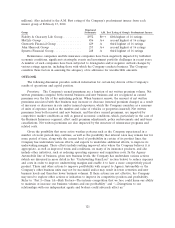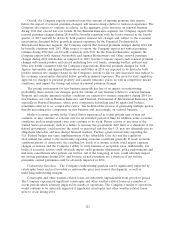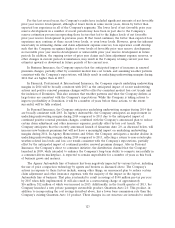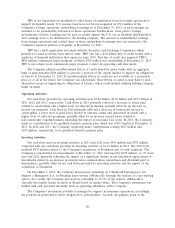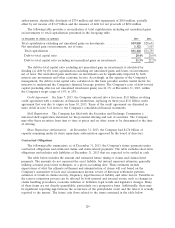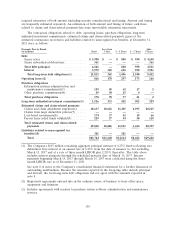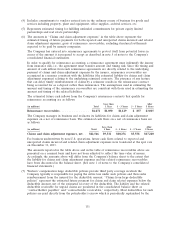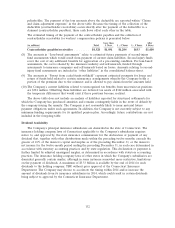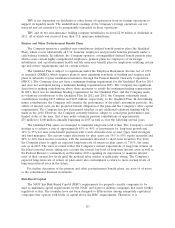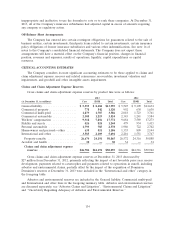Travelers 2013 Annual Report Download - page 135
Download and view the complete annual report
Please find page 135 of the 2013 Travelers annual report below. You can navigate through the pages in the report by either clicking on the pages listed below, or by using the keyword search tool below to find specific information within the annual report.desired ratings from independent rating agencies, funding of the Company’s qualified pension plan,
capital requirements of the Company’s operating subsidiaries, legal requirements, regulatory constraints,
other investment opportunities (including mergers and acquisitions and related financings), market
conditions and other factors. For information regarding the Company’s common share repurchases in
2013, see ‘‘Liquidity and Capital Resources.’’
The Company had a net after-tax unrealized investment gain of $1.15 billion in its fixed maturity
investment portfolio at December 31, 2013. While the Company does not attempt to predict future
interest rate movements, a rising interest rate environment would reduce the market value of fixed
maturity investments and, therefore, reduce shareholders’ equity, and a declining interest rate
environment would have the opposite effects. For a discussion of the risks to the Company’s business
during or following a financial market disruption and risks to the Company’s investment portfolio, see
the risk factors entitled ‘‘During or following a period of financial market disruption or economic
downturn, our business could be materially and adversely affected’’ and ‘‘Our investment portfolio may
suffer reduced returns or material realized or unrealized losses’’ included in ‘‘Part I—Item 1A—Risk
Factors.’’
Many of the statements in this ‘‘Outlook’’ section are forward-looking statements, which are
subject to risks and uncertainties that are often difficult to predict and beyond the Company’s control.
Actual results could differ materially from those expressed or implied by such forward-looking
statements. Further, such forward-looking statements speak only as of the date of this report and the
Company undertakes no obligation to update them. See ‘‘—Forward-Looking Statements.’’ For a
discussion of potential risks and uncertainties that could impact the Company’s results of operations or
financial position, see ‘‘Item 1A—Risk Factors’’ and ‘‘Item 7—Management’s Discussion and Analysis
of Financial Condition and Results of Operations—Critical Accounting Estimates.’’
LIQUIDITY AND CAPITAL RESOURCES
Liquidity is a measure of a company’s ability to generate sufficient cash flows to meet the cash
requirements of its business operations and to satisfy general corporate purposes when needed.
Operating Company Liquidity. The liquidity requirements of the Company’s insurance subsidiaries
are met primarily by funds generated from premiums, fees, income received on investments and
investment maturities. Cash provided from these sources is used primarily for claims and claim
adjustment expense payments and operating expenses. The insurance subsidiaries’ liquidity
requirements can be impacted by, among other factors, the timing and amount of catastrophe claims,
which are inherently unpredictable, as well as the timing and amount of reinsurance recoveries, which
may be affected by reinsurer solvency and reinsurance coverage disputes. Additionally, the variability of
asbestos-related claim payments, as well as the volatility of potential judgments and settlements arising
out of litigation, may also result in increased liquidity requirements. It is the opinion of the Company’s
management that the insurance subsidiaries’ future liquidity needs will be adequately met from all of
sources described above. Subject to restrictions imposed by states in which the Company’s insurance
subsidiaries are domiciled, the Company’s principal insurance subsidiaries pay dividends to their
respective parent companies, which in turn pay dividends to the corporate holding (parent) company
(TRV). For further information regarding restrictions on dividends paid by the Company’s insurance
subsidiaries, see Part I—Item 1—Regulation.’’
Holding Company Liquidity. TRV’s liquidity requirements primarily include shareholder dividends,
debt servicing, common share repurchases and, from time to time, contributions to its qualified
domestic pension plan. At December 31, 2013, TRV held total cash and short-term invested assets in
the United States aggregating $1.59 billion and having a weighted average maturity of 84 days. These
assets are sufficient to meet TRV’s current liquidity requirements and are in excess of TRV’s minimum
target level, which comprises TRV’s estimated annual pretax interest expense and common shareholder
dividends, and currently totals approximately $1.1 billion.
125


